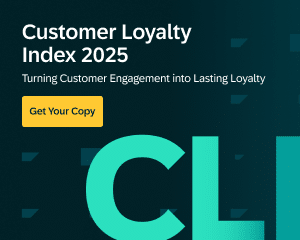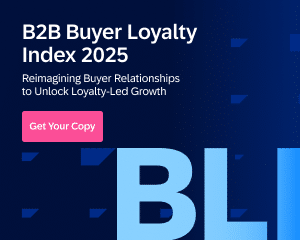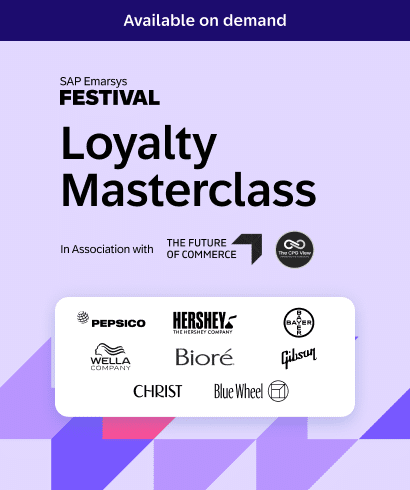What’s holding your marketing strategy back from better conversions? For many brands, it’s a fragmented customer journey. Disconnected touchpoints, generic messaging, and siloed data often result in missed opportunities and disengaged audiences.
Journey orchestration helps fix that. By aligning every interaction across channels and tailoring communication in real time, your marketers can deliver cohesive, high-impact experiences that drive results. The outcome? Higher engagement, stronger brand loyalty, and more conversions.
In this article, we break down six advanced tactics from leading brands—so you can turn your customer journey into a high-performing conversion engine.
The State of Journey Orchestration Today
Journey orchestration isn’t a buzzword—it’s a competitive necessity. According to Forrester, 81% of business buyers who’ve chosen a solution said they were dissatisfied with at least one area of their buying experience.
Your customers expect more: personalized, timely, and consistent interactions across every channel.
And the market reflects that urgency.
In fact, the global customer journey orchestration market is projected to grow from $12.5 billion in 2025 to $86.8 billion by 2034, according to Dimension Market Research. If your brand wants to stand out, journey orchestration offers a clear path forward.
6 Sophisticated Journey Orchestration Tactics
Let’s take a look at the tactics brands are using to guide their customers from discovery to purchase and loyalty:
1. Identify high-intent users early
Goal: Personalize engagement based on customer readiness.
Key benefit: Speeds up conversion for high-intent users, while nurturing others with relevant content.
Strategy: Use behavioral data to distinguish high-intent visitors from casual browsers—routing them into personalized conversion paths from the first interaction.
How it works: When visitors land on your site, real-time behavioral signals start to form a picture of their intent. Are they coming from a high-converting referral source? Are they browsing from a mobile device? Which content do they engage with first?
With the right platform, these early indicators—like time on page, scroll depth, or CTA clicks—can trigger branching journeys. High-intent users may see limited-time offers or direct purchase prompts, while lower-intent visitors might enter a nurture sequence with educational content or social proof.
AI helps continuously refine this process, learning which signals most accurately predict conversion, so your strategy improves over time.
Example: Babbel uses acquisition source and behavioral data to personalize onboarding. High-intent users see immediate purchase prompts, while others are guided through value-driven educational content.
2. Segment by motivation, not just demographics
Goal: Deliver emotionally resonant messaging.
Key benefit: Builds deeper emotional connections by aligning messages with user intent.
Strategy: Build audience segments based on deeper psychographic signals—like goals and behaviors—instead of static demographic traits.
How it works: Traditional segmentation buckets customers into broad categories like age, gender, or location. But motivations run deeper. Using surveys, behavior tracking, and psychographic data (like browsing categories or search terms), you can start building segments based on intent—why someone is interacting with your brand in the first place.
Advanced platforms like SAP Emarsys integrate machine learning to spot trends and automatically update segments as user behavior shifts. Someone initially motivated by curiosity may show signs of urgency later—your orchestration system should reflect that.
This dynamic segmentation allows you to serve more empathetic messaging, like encouraging stories for self-improvement seekers or value propositions for price-conscious shoppers.
Example: Language learning app, Babbel, segments learners by purpose—career growth, travel, or personal enrichment—to ensure their messaging reflects each user’s motivation.

3. Use real-time channel preferences to guide orchestration
Goal: Match the message to the moment and engage your customers in the right place.
Key benefit: Drives higher engagement and reduces opt-outs.
Strategy: Dynamically adapt delivery methods based on each user’s preferred channel and engagement behavior to maximize relevance and timing.
How it works: Every customer has a preferred way to engage—some check email regularly, others prefer SMS, push, or even WhatsApp. Real-time engagement tracking shows where and when each user is most responsive.
Platforms analyze which channels lead to the highest engagement for each person and adjust delivery routes accordingly. For instance, a user who habitually clicks push notifications in the morning might receive mobile nudges timed for their commute, while another might engage more with evening email digests.
Orchestration tools can also account for message type—urgent reminders might go to mobile, while more thoughtful content (like a new product guide) gets delivered via email. This mix boosts both relevance and response rates.
Example: Babbel found that push notifications outperform email by 50% for learning reminders, so they use push for quick nudges and reserve email for deeper content.
4. Connect online and offline data for seamless omnichannel journeys
Goal: Unify experiences across physical and digital channels.
Key benefit: Builds trust and satisfaction by delivering a continuous brand experience.
Strategy: Centralize customer data from every interaction—digital and physical—into a single source of truth to deliver consistent cross-channel experiences.
How it works: Customers move fluidly between digital and physical touchpoints—but many brands treat those interactions separately. Journey orchestration unifies online behaviors (like web sessions and app usage) with offline actions (such as store visits or point-of-sale data) by syncing data through a centralized customer profile.
That profile powers intelligent experiences. A customer who browses shoes online and then visits a retail location can receive a timely message about in-store availability or a loyalty reward. Conversely, a loyalty swipe in-store might trigger a follow-up email with online-exclusive offers.
APIs, data connectors, and cloud integrations are key here—they ensure real-time data flow so no touchpoint feels out of sync.
Example: Majid Al Futtaim integrates data across malls, apps, and ecommerce to create personalized experiences, whether a customer is browsing online or walking into a store.
5. Automate personalization with AI
Goal: Scale one-on-one experiences efficiently.
Key benefit: Engages every customer with relevance, without increasing manual effort.
Strategy: Use AI-powered decisioning to efficiently predict customer needs, automating personalized content, timing, and channel selection.
How it works: AI personalization doesn’t just automate basic rules—it continuously analyzes customer behavior to predict what action a user will likely take next and adapts content accordingly.
That could mean selecting the best product recommendation, choosing the ideal message timing, or dynamically assembling an email layout based on current preferences. AI can test multiple variations (A/B/n) in real time to optimize performance across audiences.
This takes manual guesswork out of segmentation and campaign building. Instead of creating 10 versions of a message for different groups, AI automatically adapts one core message to match each recipient’s preferences, behavior, and timing.
Example: Majid Al Futtaim uses SAP Emarsys AI to power personalized campaigns across email, SMS, and WhatsApp—delivering better ROI and deeper engagement at scale.
6. Turn loyalty programs into personalization engines
Goal: Strengthen relationships and increase retention.
Key benefit: Transforms loyalty into a two-way value exchange that feels personal.
Strategy: Leverage loyalty program data as a dynamic input for journey orchestration, fueling more targeted offers, rewards, and communications.
How it works: Your loyalty program isn’t just a rewards engine; it’s a rich source of behavioral and transactional data. Each interaction—redeeming points, visiting a store, opening a loyalty email—adds to the customer’s profile.
Feeding that data into your journey orchestration system allows you to trigger intelligent experiences based on milestones, tier changes, or inactivity. A first-time points redemption might trigger a thank-you campaign, while a drop in engagement could prompt a reactivation offer tied to their interests.
You can also layer in exclusivity—using loyalty data to offer early access, sneak peeks, or personalized product drops that drive urgency and emotional loyalty.
Example: True Religion revamped its loyalty program to offer custom incentives and exclusive product drops tied to online and in-store behavior.
Brand Success Stories in Action
We’ve talked about journey orchestration tactics, but what do they look like in practice? Next up, let’s take a look at examples from brands who’ve put them into action:
Babbel: Delivering personalized learning at scale

Brand overview: Babbel, a global language learning app, serves over 10 million users. Its mission: make learning engaging and personalized through innovative technology.
Challenges: Learner motivation drops without personal guidance. Babbel needed to boost engagement and encourage consistent usage.
Solutions: Babbel personalized journeys using acquisition and behavioral data to guide onboarding and content delivery. Using SAP Emarsys’s predictive real-time segmentation capabilities, they integrated push and in-app messages to create a tailored experience that met learners where they were.
Results: Push notifications converted 50% better than email for learning nudges. Personalized orchestration improved retention and course completion rates.
"People are not stupid. They know that it's still mass production in a way. But we want to make sure they understand that we try our best to understand them and their needs personally, and the dream that inspired them to sign up with Babbel."
True Religion: Creating authentic connections
Brand overview: Known for its premium denim, True Religion relaunched with a renewed focus on authenticity and cultural connection.
Challenges: After bankruptcy, the brand needed to rebuild trust with younger, digital-first customers and reignite in-store engagement.
Solutions: With the SAP Emarsys customer engagement platform, True Religion built omnichannel marketing campaigns around authentic brand ambassadors—artists, athletes, and influencers with genuine affinity for the brand. It also overhauled its loyalty program to capture behavior across digital and physical channels.
Results: Instagram followers grew by 20%, engagement nearly doubled, and TikTok followers surged 500%. Loyalty members spent 50% more than non-members, and in-store activations drove higher foot traffic and engagement.
"We want to make sure the marketing is always authentic, so we don't just pay people to sign up and rep the brand. We really want to make sure that they have a genuine and authentic love for the brand and the product." Kristin D'Arcy, CMO, True Religion
Majid Al Futtaim: Orchestrating seamless omnichannel journeys
Brand overview: Majid Al Futtaim is a leading Middle Eastern retail and lifestyle group with malls, supermarkets, and entertainment brands across the region.
Challenges: With a wide mix of business units and channels, the brand needed to unify customer data and deliver consistent, high-value experiences.
Solutions: Majid Al Futtaim centralized customer data from malls, loyalty programs, and ecommerce into a single system. Using SAP Emarsys, the brand activated AI-powered personalization across SMS, email, WhatsApp, and in-store experiences. Their SHARE loyalty program connected data across touchpoints to fuel smarter journeys.
Results: AI-driven campaigns boosted engagement and efficiency. Micro-campaigns increased store visits and customer acquisition—proving that connected journeys lead to measurable growth.
"It's not really authentic just to talk about the buzzwords. You need to find what makes sense from an investment perspective, from a customer perspective."
Looking Ahead: The Future of Journey Orchestration
As marketing tech evolves, journey orchestration will become even more intelligent. Expect AI to play a bigger role, powering real-time personalization and predictive decision-making across every channel.
For marketers, one thing is clear: connected, personalized customer journeys aren’t optional—they’re essential. By implementing these six tactics, you can transform disconnected interactions into conversion-driving journeys that build loyalty and deliver lasting business results.
Turn disconnected touchpoints into connected experiences with SAP Emarsys.
Orchestrate personalized, real-time journeys across every channel—email, mobile, web, and in-store—with a platform built to scale. SAP Emarsys gives marketers the tools to unify data, act on intent signals, and deliver results that move the needle on conversion and loyalty.
Ready to see omnichannel customer journeys in action? Book your demo now.







